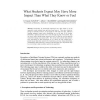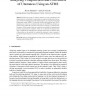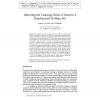333 search results - page 57 / 67 » Game-Driven Intelligent Tutoring Systems |
AIED
2009
Springer
14 years 2 months ago
2009
Springer
Researchers of educational technologies are often asked to do the impossible: make students learn and have them enjoy it. These two objectives, though not mutually exclusive, are f...
AIED
2005
Springer
14 years 1 months ago
2005
Springer
Analyzing coverage of a student’s utterance or essay (completeness) and diagnosing errors (correctness) can be treated as a diagnosis problem and solved using a well-known techni...
ITS
1998
Springer
13 years 12 months ago
1998
Springer
We present a vision for learning environments, called Science Learning Spaces, that are rich in engaging content and activities, provide constructive experiences in scientific proc...
AIED
2009
Springer
14 years 2 months ago
2009
Springer
Researchers that make tutoring systems would like to know which pieces of educational content are most effective at promoting learning among their students. Randomized controlled e...
ITS
2004
Springer
14 years 1 months ago
2004
Springer
The ability to use help-resources efficiently is an important skill in any learning environment, whether the student is in a traditional classroom or is using an Intelligent Tutor...



